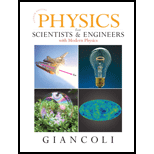
Physics for Scientists and Engineers with Modern Physics
4th Edition
ISBN: 9780131495081
Author: Douglas C. Giancoli
Publisher: Addison-Wesley
expand_more
expand_more
format_list_bulleted
Question
Chapter 40, Problem 5P
To determine
Find the repulsion energy of the electron shells of LiF molecule.
Expert Solution & Answer
Want to see the full answer?
Check out a sample textbook solution
Students have asked these similar questions
A capacitor with a capacitance of C = 5.95×10−5 F is charged by connecting it to a 12.5 −V battery. The capacitor is then disconnected from the battery and connected across an inductor with an inductance of L = 1.55 H . At the time 2.35×10−2 s after the connection to the inductor is made, what is the current in the inductor? At that time, how much electrical energy is stored in the inductor?
Can someone help me with this question. Thanks.
Can someone help me with this question. Thanks.
Chapter 40 Solutions
Physics for Scientists and Engineers with Modern Physics
Ch. 40.4 - Determine the three lowest rotational energy...Ch. 40.6 - Prob. 1BECh. 40.6 - Prob. 1CECh. 40.8 - Prob. 1DECh. 40 - What type of bond would you expect for (a) the N2...Ch. 40 - Describe how the molecule CaCl2 could be formed.Ch. 40 - Does the H2 molecule have a permanent dipole...Ch. 40 - Although the molecule H3 is not stable, the ion...Ch. 40 - The energy of a molecule can be divided into four...Ch. 40 - Would you expect the molecule H2+ to be stable? If...
Ch. 40 - Explain why the carbon atom (Z = 6) usually forms...Ch. 40 - Prob. 8QCh. 40 - Prob. 9QCh. 40 - Prob. 10QCh. 40 - Prob. 11QCh. 40 - Prob. 12QCh. 40 - Prob. 13QCh. 40 - Prob. 14QCh. 40 - Prob. 15QCh. 40 - Prob. 16QCh. 40 - Prob. 17QCh. 40 - Prob. 18QCh. 40 - Prob. 19QCh. 40 - Prob. 20QCh. 40 - Prob. 21QCh. 40 - Prob. 22QCh. 40 - Prob. 23QCh. 40 - Prob. 1PCh. 40 - (II) The measured binding energy of KCl is 4.43eV....Ch. 40 - (II) Estimate the binding energy of the H2...Ch. 40 - (II) The equilibrium distance r0 between two atoms...Ch. 40 - Prob. 5PCh. 40 - Prob. 6PCh. 40 - (III) (a) Apply reasoning similar to that in the...Ch. 40 - (I) Show that the quantity 2/I has units of...Ch. 40 - Prob. 9PCh. 40 - Prob. 10PCh. 40 - Prob. 11PCh. 40 - Prob. 12PCh. 40 - Prob. 13PCh. 40 - Prob. 14PCh. 40 - Prob. 15PCh. 40 - Prob. 16PCh. 40 - (II) Calculate the bond length for the NaCl...Ch. 40 - Prob. 18PCh. 40 - Prob. 19PCh. 40 - Prob. 20PCh. 40 - Prob. 21PCh. 40 - Prob. 22PCh. 40 - Prob. 23PCh. 40 - Prob. 24PCh. 40 - Prob. 25PCh. 40 - Prob. 26PCh. 40 - Prob. 27PCh. 40 - Prob. 28PCh. 40 - Prob. 29PCh. 40 - Prob. 30PCh. 40 - Prob. 31PCh. 40 - Prob. 32PCh. 40 - Prob. 33PCh. 40 - Prob. 34PCh. 40 - Prob. 35PCh. 40 - Prob. 36PCh. 40 - Prob. 37PCh. 40 - Prob. 38PCh. 40 - Prob. 39PCh. 40 - Prob. 40PCh. 40 - Prob. 41PCh. 40 - Prob. 42PCh. 40 - Prob. 43PCh. 40 - Prob. 44PCh. 40 - Prob. 45PCh. 40 - Prob. 46PCh. 40 - Prob. 47PCh. 40 - Prob. 48PCh. 40 - Prob. 49PCh. 40 - Prob. 50PCh. 40 - Prob. 51PCh. 40 - Prob. 52PCh. 40 - Prob. 53PCh. 40 - Prob. 54PCh. 40 - Prob. 55PCh. 40 - Prob. 56PCh. 40 - Prob. 57PCh. 40 - Prob. 58PCh. 40 - Prob. 59PCh. 40 - Prob. 60PCh. 40 - Prob. 61PCh. 40 - Prob. 62GPCh. 40 - Prob. 63GPCh. 40 - Prob. 64GPCh. 40 - Prob. 65GPCh. 40 - Prob. 66GPCh. 40 - Prob. 67GPCh. 40 - Prob. 68GPCh. 40 - Prob. 69GPCh. 40 - Prob. 70GPCh. 40 - Prob. 71GPCh. 40 - Prob. 72GPCh. 40 - Prob. 73GPCh. 40 - Prob. 74GPCh. 40 - Prob. 75GPCh. 40 - Prob. 76GPCh. 40 - Prob. 77GPCh. 40 - Prob. 78GPCh. 40 - Prob. 79GPCh. 40 - Prob. 80GPCh. 40 - Prob. 81GPCh. 40 - Prob. 82GPCh. 40 - Prob. 83GPCh. 40 - Prob. 84GPCh. 40 - Prob. 85GPCh. 40 - Prob. 86GPCh. 40 - Prob. 87GPCh. 40 - Prob. 88GPCh. 40 - Prob. 89GP
Knowledge Booster
Similar questions
- Can someone help me with this question. Thanks.arrow_forwardIdentical rays of light enter three transparent blocks composed of different materials. Light slows down upon entering the blocks.arrow_forwardFor single-slit diffraction, calculate the first three values of (the total phase difference between rays from each edge of the slit) that produce subsidiary maxima by a) using the phasor model, b) setting dr = 0, where I is given by, I = Io (sin (10) ². 2arrow_forward
arrow_back_ios
SEE MORE QUESTIONS
arrow_forward_ios
Recommended textbooks for you
 Modern PhysicsPhysicsISBN:9781111794378Author:Raymond A. Serway, Clement J. Moses, Curt A. MoyerPublisher:Cengage Learning
Modern PhysicsPhysicsISBN:9781111794378Author:Raymond A. Serway, Clement J. Moses, Curt A. MoyerPublisher:Cengage Learning University Physics Volume 3PhysicsISBN:9781938168185Author:William Moebs, Jeff SannyPublisher:OpenStax
University Physics Volume 3PhysicsISBN:9781938168185Author:William Moebs, Jeff SannyPublisher:OpenStax Physics for Scientists and Engineers with Modern ...PhysicsISBN:9781337553292Author:Raymond A. Serway, John W. JewettPublisher:Cengage Learning
Physics for Scientists and Engineers with Modern ...PhysicsISBN:9781337553292Author:Raymond A. Serway, John W. JewettPublisher:Cengage Learning Glencoe Physics: Principles and Problems, Student...PhysicsISBN:9780078807213Author:Paul W. ZitzewitzPublisher:Glencoe/McGraw-Hill
Glencoe Physics: Principles and Problems, Student...PhysicsISBN:9780078807213Author:Paul W. ZitzewitzPublisher:Glencoe/McGraw-Hill Physics for Scientists and Engineers, Technology ...PhysicsISBN:9781305116399Author:Raymond A. Serway, John W. JewettPublisher:Cengage Learning
Physics for Scientists and Engineers, Technology ...PhysicsISBN:9781305116399Author:Raymond A. Serway, John W. JewettPublisher:Cengage Learning

Modern Physics
Physics
ISBN:9781111794378
Author:Raymond A. Serway, Clement J. Moses, Curt A. Moyer
Publisher:Cengage Learning

University Physics Volume 3
Physics
ISBN:9781938168185
Author:William Moebs, Jeff Sanny
Publisher:OpenStax

Physics for Scientists and Engineers with Modern ...
Physics
ISBN:9781337553292
Author:Raymond A. Serway, John W. Jewett
Publisher:Cengage Learning


Glencoe Physics: Principles and Problems, Student...
Physics
ISBN:9780078807213
Author:Paul W. Zitzewitz
Publisher:Glencoe/McGraw-Hill

Physics for Scientists and Engineers, Technology ...
Physics
ISBN:9781305116399
Author:Raymond A. Serway, John W. Jewett
Publisher:Cengage Learning